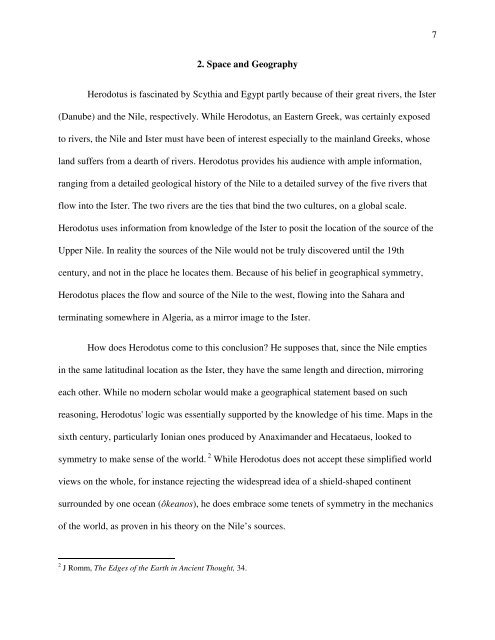The Old and the Restless - The Egyptians and the Scythians in Herodotus' Histories by Robert J. Hagan
You also want an ePaper? Increase the reach of your titles
YUMPU automatically turns print PDFs into web optimized ePapers that Google loves.
7<br />
2. Space <strong>and</strong> Geography<br />
Herodotus is fasc<strong>in</strong>ated <strong>by</strong> Scythia <strong>and</strong> Egypt partly because of <strong>the</strong>ir great rivers, <strong>the</strong> Ister<br />
(Danube) <strong>and</strong> <strong>the</strong> Nile, respectively. While Herodotus, an Eastern Greek, was certa<strong>in</strong>ly exposed<br />
to rivers, <strong>the</strong> Nile <strong>and</strong> Ister must have been of <strong>in</strong>terest especially to <strong>the</strong> ma<strong>in</strong>l<strong>and</strong> Greeks, whose<br />
l<strong>and</strong> suffers from a dearth of rivers. Herodotus provides his audience with ample <strong>in</strong>formation,<br />
rang<strong>in</strong>g from a detailed geological history of <strong>the</strong> Nile to a detailed survey of <strong>the</strong> five rivers that<br />
flow <strong>in</strong>to <strong>the</strong> Ister. <strong>The</strong> two rivers are <strong>the</strong> ties that b<strong>in</strong>d <strong>the</strong> two cultures, on a global scale.<br />
Herodotus uses <strong>in</strong>formation from knowledge of <strong>the</strong> Ister to posit <strong>the</strong> location of <strong>the</strong> source of <strong>the</strong><br />
Upper Nile. In reality <strong>the</strong> sources of <strong>the</strong> Nile would not be truly discovered until <strong>the</strong> 19th<br />
century, <strong>and</strong> not <strong>in</strong> <strong>the</strong> place he locates <strong>the</strong>m. Because of his belief <strong>in</strong> geographical symmetry,<br />
Herodotus places <strong>the</strong> flow <strong>and</strong> source of <strong>the</strong> Nile to <strong>the</strong> west, flow<strong>in</strong>g <strong>in</strong>to <strong>the</strong> Sahara <strong>and</strong><br />
term<strong>in</strong>at<strong>in</strong>g somewhere <strong>in</strong> Algeria, as a mirror image to <strong>the</strong> Ister.<br />
How does Herodotus come to this conclusion? He supposes that, s<strong>in</strong>ce <strong>the</strong> Nile empties<br />
<strong>in</strong> <strong>the</strong> same latitud<strong>in</strong>al location as <strong>the</strong> Ister, <strong>the</strong>y have <strong>the</strong> same length <strong>and</strong> direction, mirror<strong>in</strong>g<br />
each o<strong>the</strong>r. While no modern scholar would make a geographical statement based on such<br />
reason<strong>in</strong>g, <strong>Herodotus'</strong> logic was essentially supported <strong>by</strong> <strong>the</strong> knowledge of his time. Maps <strong>in</strong> <strong>the</strong><br />
sixth century, particularly Ionian ones produced <strong>by</strong> Anaxim<strong>and</strong>er <strong>and</strong> Hecataeus, looked to<br />
symmetry to make sense of <strong>the</strong> world. 2 While Herodotus does not accept <strong>the</strong>se simplified world<br />
views on <strong>the</strong> whole, for <strong>in</strong>stance reject<strong>in</strong>g <strong>the</strong> widespread idea of a shield-shaped cont<strong>in</strong>ent<br />
surrounded <strong>by</strong> one ocean (ôkeanos), he does embrace some tenets of symmetry <strong>in</strong> <strong>the</strong> mechanics<br />
of <strong>the</strong> world, as proven <strong>in</strong> his <strong>the</strong>ory on <strong>the</strong> Nile’s sources.<br />
2 J Romm, <strong>The</strong> Edges of <strong>the</strong> Earth <strong>in</strong> Ancient Thought, 34.
















